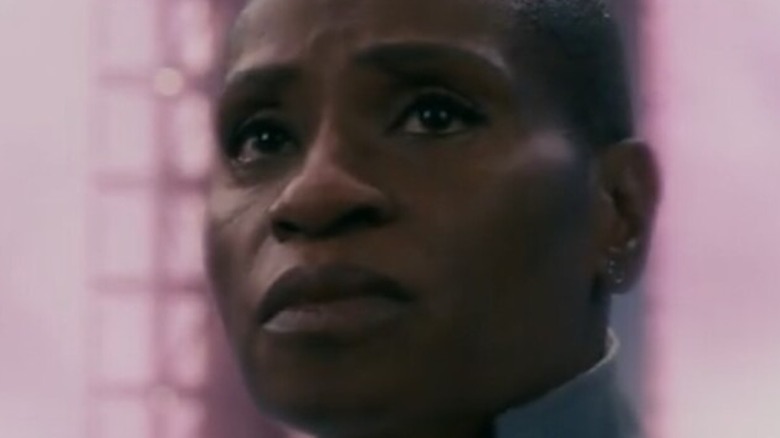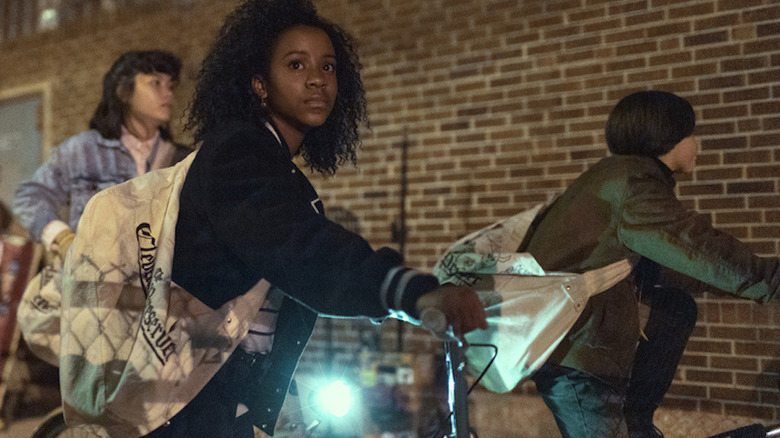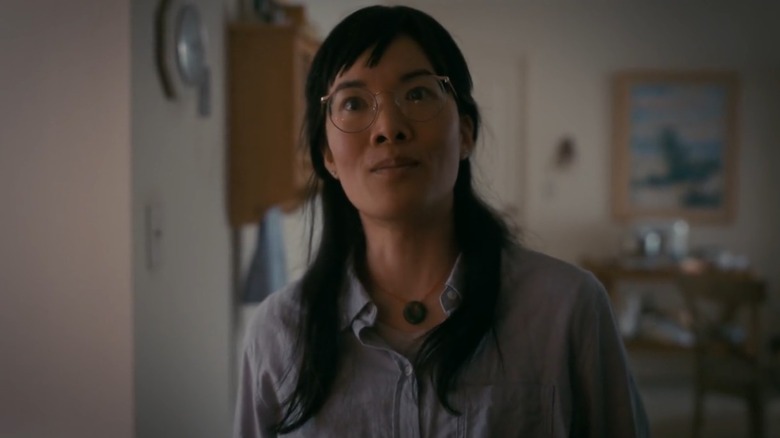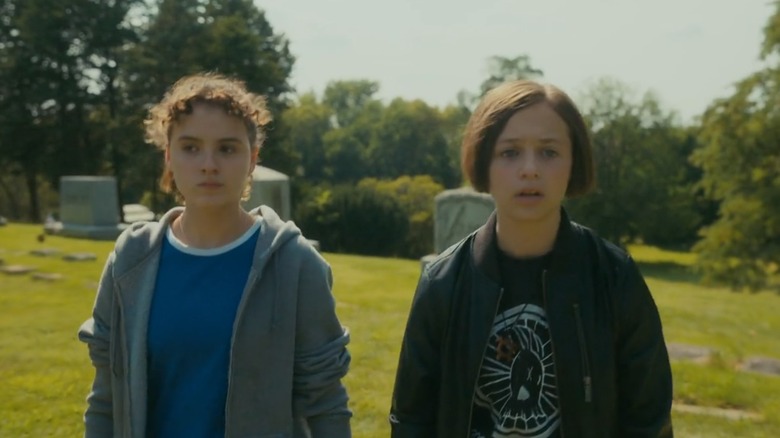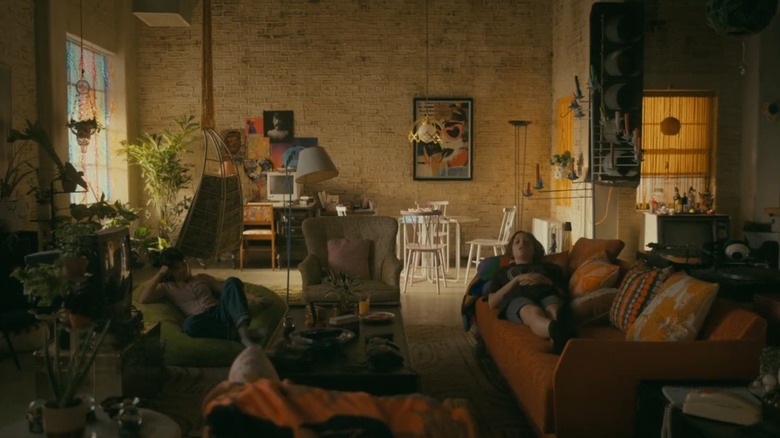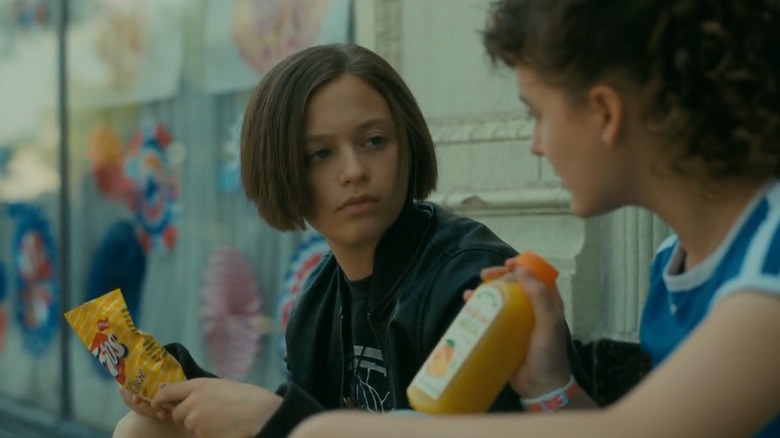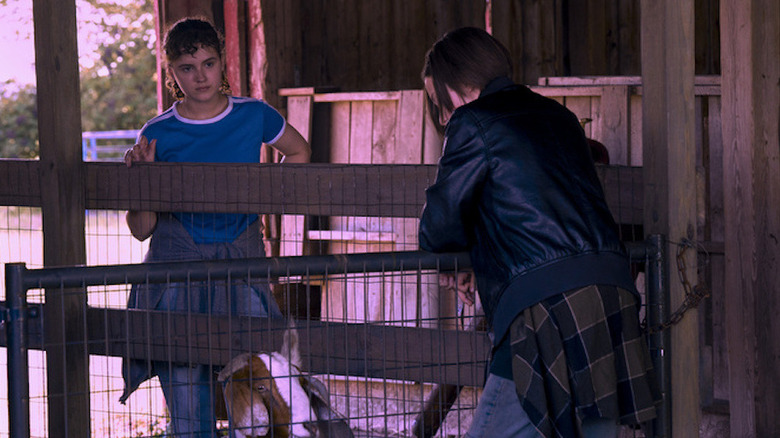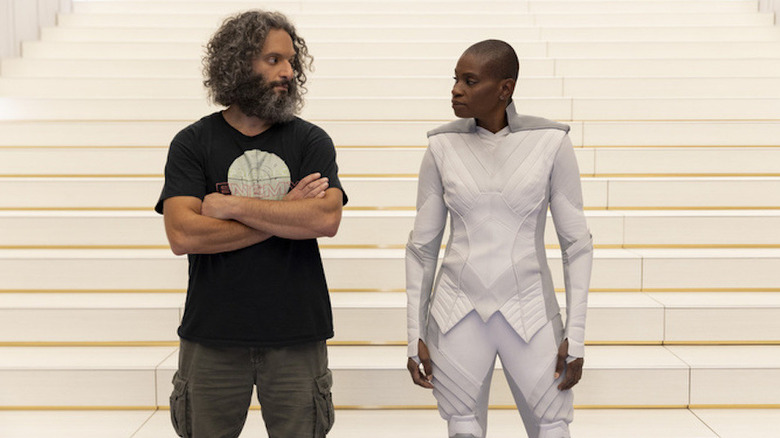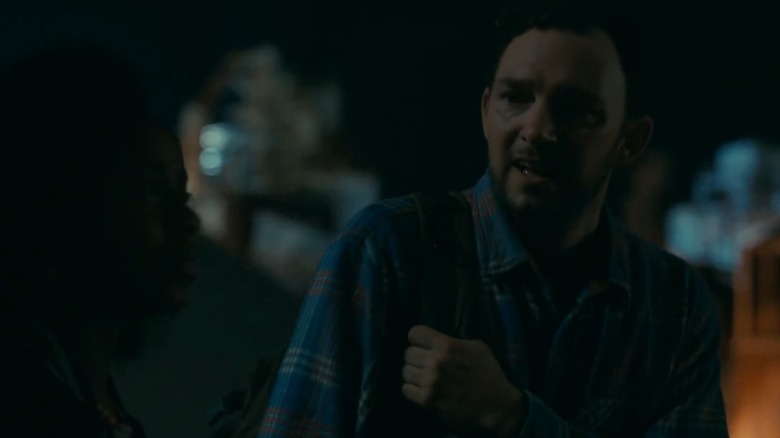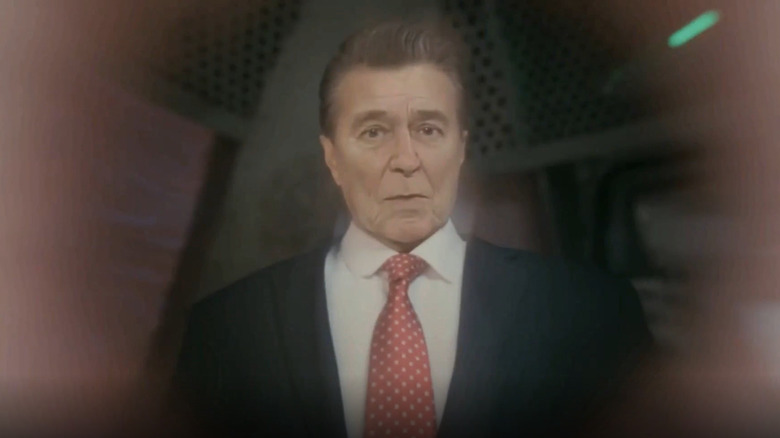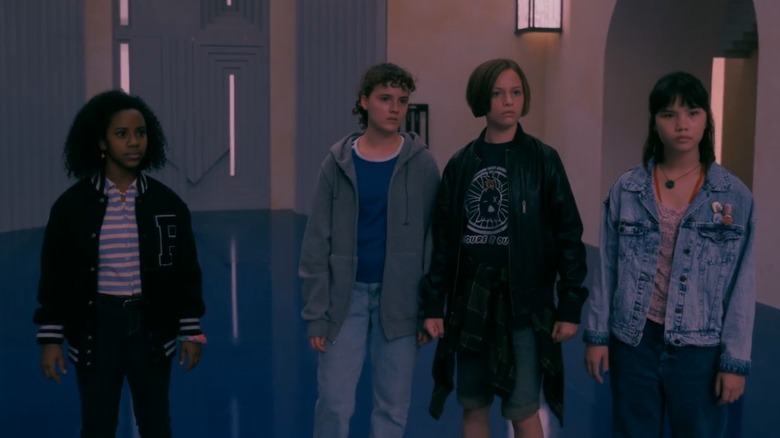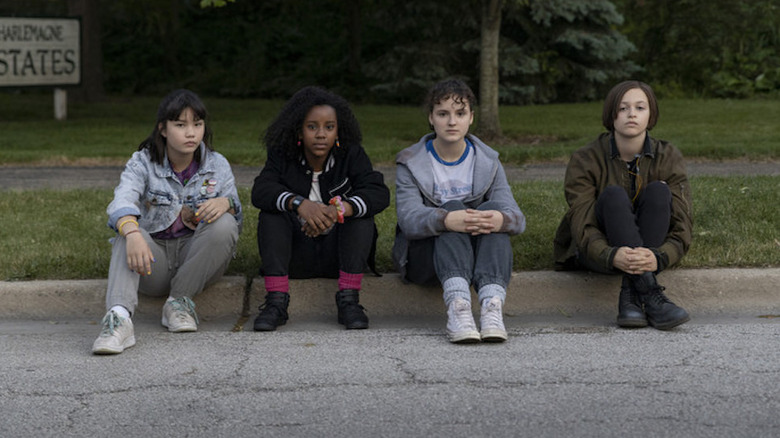The Ending Of Amazon Prime's Paper Girls Season 1 Explained
"Paper Girls" existed before "Stranger Things" was even a thing, but the Amazon Prime series will strike a chord with anyone who's a fan of the Duffer Brothers' sci-fi horror saga. An '80s setting? Check? A compelling story about the horrors of adolescence that boasts otherworldly concepts? Check. Sociopolitical commentary about the anxieties of yesteryear? Check. That said, "Paper Girls" is its own beast entirely, and Season 1 only scratches the surface of the universe's grand mythology.
Based on Brian K. Vaughan and Cliff Chiang's Eisner Award-winning series of the same name (which was released by Image Comics in 2015), "Paper Girls" follows the titular quartet of 12-year-old girls — Mac (Sofia Rosinsky), Erin (Riley Nai Lelet), KJ (Fina Strazza), and Tiff (Camryn Jones) — as they travel through time. Along the way, they encounter warring factions, their future selves, and dinosaurs with an appetite for human flesh. But that's nothing compared to the existential dilemmas that each of the girls must comprehend as the dramatic events unfold.
Season 1 of "Paper Girls" is full of interesting character journeys, complex themes, and unexpected twists and turns. Whether it's dealing with time travel or tapping into universal truths that are grounded in reality, there's a lot to unpack by the time the finale's ending credits roll. With that in mind, let's break it down and figure out what it all means.
Spoilers ahead for all of "Paper Girls."
Nostalgia isn't all it's cracked up to be
Pop culture has been obsessed with the '80s in recent years. We have shows like "Stranger Things" to thank for the craze. However, while "Paper Girls will undoubtedly draw comparisons to much of the '80s-nostalgic media that's out there, the show isn't interested in glamourizing the beloved decade. In fact, "Paper Girls" is a reminder that the '80s really sucked at times.
"Paper Girls" is more about embracing the future than reveling in the past. From Erin's dream of becoming a senator to Mac's desire to leave behind her troubled home life and never look back, it's a story about characters who want to move forward. Furthermore, "Paper Girls" brings to light some of the bigotry and paranoia that was prevalent in the 1980s, especially in regard to racism, antisemitism, homophobia, and moral panics.
Basically, the goal of the series is to remind viewers that the '80s shouldn't be fondly remembered in every aspect. Per Variety, Brian K. Vaughan has described the story as a "death threat" to yesteryear, stating that he wants people to recognize that humanity has made a lot of progress since then, and that's worth celebrating.
The sad reality of adulthood
"Paper Girls" might not want to dwell on the past, but it doesn't portray the future as kittens and rainbows either. When the children meet their adult selves, they realize that life didn't work out according to plan. Erin grew up to become a jaded freelance paralegal who grew estranged from her sister. Tiff got expelled from her dream college and ended up dating a guy she didn't even like. Mac passed away at the age of 16 and never escaped her abusive home life. KJ found happiness, but it's implied that there was a disconnect between her and her family as they didn't approve of her career goals.
The interactions between the kids and their older selves convey a major theme of "Paper Girls": the contrast between the dreamy-eyed optimism of youth and the sad reality of being an adult. The kids haven't been burned and hurt yet, whereas their grown-up counterparts are trying to find their purpose and deal with the unexpected curveballs life has thrown at them. And if adult Erin's unfortunate demise revealed anything, it's that finding happily ever after isn't always guaranteed after years of suffering.
In the end, the kids and adults could arguably learn something from each other. The children should brace themselves for life taking some unexpected turns, while their older versions could benefit from remembering some of the things that fueled them back in the day.
Confronting death and the darker side of life
The young cast of "Paper Girls" watched lots of coming-of-age movies and '80s classics while prepping for the show. One of those movies was none other than "Stand By Me" (per The Hollywood Reporter), which shares a lot of thematic similarities with the Amazon series.
Based on Stephen King's short story "The Body," "Stand By Me" follows a group of adolescent boys who discover a dead body by the side of a railway track, effectively ending their childhoods as they know it. The film also examines how death can affect young people, while simultaneously exploring themes such as abuse and dysfunctional families. Some pundits have claimed that "Stand By Me" is the best King adaptation, and while that's up for debate, there's no denying that it's one of the most influential.
"Paper Girls" is another coming-of-age tale about children confronting death and the harsher realities of the world. That said, the Amazon series takes it one step further by exposing some of the young characters to their own deaths, resulting in moments of personal reflection and existential dread that constantly linger. Erin and Mac spend much of the season knowing how and when they'll die, and by the time the finale's end credits appear on the screen, they still haven't fully processed the information.
Erin and Mac's doomed fates aren't so certain after all
Fortunately for Mac and Erin, there might be a way to escape their scheduled death dates. Before Prioress (Adina Porter) puts the girls into pods and sends them traveling through time, she tells them that they still have the chance to save their "sick friend" aka Mac. All they have to do is prevent the time war from ever happening, which will be easier said than done.
Prioress also informs Erin that the future can be what she makes it, suggesting that she still has time to make decisions that will lead to a more promising outcome for her down the line. Of course, this makes sense as adult Erin died while battling a giant robot in the throes of battle. If the war doesn't happen, then it's highly unlikely that she'll ever find herself piloting machines and having boxing matches. Prioress' words also suggest that Erin can change the events that distracted her from achieving her goals and led to the fallout with her sister.
It remains to be seen how the gang will bend the rules of time to make everything right moving forward, but Prioress' revelations instilled them with some hope and gave them a reason to keep fighting for their respective futures. Stopping a horrible war and saving humankind is just an added bonus.
Mac's subtle transformation
Mac's story is arguably the most heartbreaking of the bunch on "Paper Girls." She's an offensive outcast with a troubled home life, which she opens up about during her conversations with her older brother. By the end of the series, she realizes that the death of her future self had a profound effect on her family, causing her to rethink how she's always perceived her loved ones. More than that, Mac also starts to question who she is and what will become of her.
In the future, Mac's older brother tells her that she has no idea about the great person she's about to become. Toward the end of the season, we start to see changes in her character that hint toward the upcoming changes. For a start, she slowly begins to break down her emotional walls and embrace her newfound friendships, even though she insists that she won't be wearing a dress to KJ's bar mitzvah, should they survive their predicament.
Mac's journey also sees her become more tolerant. In the second episode, she taunts KJ with antisemitic jokes and it's heavily implied that she was responsible for vandalizing KJ's locker with offensive slurs in the past. Later on in the series, Mac confides in KJ about her death, indicating that she no longer harbors any resentment toward her peer.
KJ's journey of self-discovery
As previously mentioned, "Paper Girls" doesn't shy away from the horrors of adolescence and life in general, but it's not all doom and gloom at the end of the day. The series is littered with a few optimistic, feel-good moments, especially when it comes to KJ's transformation throughout Season 1.
Early on, KJ worries about growing up to become a violent person following the hockey stick incident that saw her accidentally kill someone. Upon meeting her future girlfriend Lauren (Maren Lord), however, she starts to feel better. The hockey-loving 12-year-old falls in love with Stanley Kubrick movies and this sparks her interest in filmmaking. She also starts taking steps toward embracing her sexuality, though it's still a process that she's figuring out. As Lauren told her, "everyone moves at their own pace" and that's okay.
Ending the war will also give KJ an opportunity to prevent the unfortunate incident that traumatizes her throughout the season. While she's grateful to know that she has things to look forward to, it's clear that she has a guilty conscience over the aforementioned killing incident. As such, she wants to make things right before it's all said and done.
How does time travel work on Paper Girls?
"Back to the Future" taught us to believe that course correcting time has dire consequences for the universe. That said, almost every story about time travel portrays the concept as messy, confusing, and something that should not be tampered with. "Paper Girls" is no different in that regard, but the rules currently remain shrouded in mystery, for the most part.
"Paper Girls" offers a couple of explanations about time travel and leaves it up to the viewer to decide which one makes the most sense (at least for now). According to Larry, a loyal soldier of the STF Underground, stopping moments where humankind lost its way is essential for creating a better world for everyone. The Old Watch, meanwhile, believes that time is like a "mixtape," and constantly changing it means that it'll eventually unravel.
So, the big question is: who's telling the truth? Both parties have a strong case. According to Comicsly, traveling to the past to try and change events only causes the ribbon of time to grow stronger, effectively making it impossible to permanently alter the future. That said, Prioress' revelations in the finale prove that there are ways to erase certain events from history, which will hopefully become clearer in the next installment of "Paper Girls."
War makes people do questionable things
By the end of Season 1, it's pretty clear that the Old Watch are the bad guys in the secret Time Wars. Their leader (played by Jason Mantzoukas) feeds Larry (Nate Corddry) to a dinosaur, after all, so it's pretty clear that he has a mean streak. The Underground has issues too, though, as the fifth episode sees Larry lie to the show's heroic quartet so that Erin will transport him to the year 1999 for a mission. This came after Larry told everyone that they'd drop by 1988 first so that the girls could return to their own timeline. In the end, his actions cause both him and Erin to die in battle — right in front of the kids.
Throughout the season, we're also led to believe that Prioress is an unadulterated villain who wants to kill Mac, KJ, Tiff, and Erin. This is proven to be false, of course, after she gives her life so that the Paper Girls can escape their imprisonment and stop the Time War from happening in the first place. Peace is worth dying for.
If there's a moral to this story, it's that both sides are capable of brutality and making poor decisions. Furthermore, there are sections within each faction that never wanted the war to happen in the first place. Unfortunately, those who are driven by their own ideological goals stand in the way of both sides finding common ground.
There's more to Paper Girls' Ronald Reagan than politics
If the goal of "Paper Girls" is to remind viewers that the '80s had its downsides, then frequently referencing the polarizing president who governed America for most of the decade is one way to emphasize the point. Most of the references to the former president come in the form of newspaper headlines that highlight the Cold War paranoia of the time period. However, the former commander-in-chief also appears as a manifestation in young Erin's fever dreams.
The first time Reagan visits Erin's subconscious, he's a supportive figure who helps her through a crisis. He tells her to be brave after she gets shot and informs the 12-year-old that not all gunshot wounds end in death. In the sixth episode, though, he prays on her insecurities by telling her that all she does is standby while bad things happen. Talk about mixed messages, right?
Erin's connection to Reagan is more personal than political, and there's a reason for this. The idea was lifted from the comics, which expressed how many American children looked up to the ex-president in the 1980s. Brian K. Vaughan told The Daily Beast that Reagan seemed like a comforting figure before children were old enough to agree or disagree with his politics. "He was basically Optimus Prime," Vaughan recalled. "The Reagan years were eight formative years of my life, in which he was presented as equal parts superhero and surrogate father."
Who is Doctor Braunstein?
In the final episode, Prioress mentions a woman by the name of Doctor Braunstein who made discoveries that led to the Time War breaking out in the first place. Prioress informs the girls that they become part of the doctor's team as it was affiliated with the Quilkin Institute, which was set up by Tiff's older self. That means future Tiff successfully deciphers the codes from Larry's notebook that she hid in her car prior to having her memories wiped. In short, Tiff eventually masters the art of time travel.
But who is the mysterious Braunstein that Prioress spoke of prior to her demise? Well, it turns out that the doc's significance to the development of time travel cannot be overstated. According to Nerdist, the comics version of Braunstein basically invented it, only to end up traveling to the year 11,706 BCE. However, she's ultimately saved from the prehistoric era and brought to the year 2055.
Prioress namedropping Braunstein and noting that the girls eventually cross paths with her suggests that she'll appear in the television series at some point. If that does indeed happen, it could mean a trip to the prehistoric ages for the gang.
What does the future hold for Paper Girls?
The closing moments of "Paper Girls'" epic finale transport Tiff and Erin to the past. Their friends are nowhere to be seen, though, so it's safe to assume that they traveled to another time period after escaping in their pod. If that's the case, the next chapter will cover more of the past and future. The characters will be thrust into situations in which they're sometimes forced to contend with insurmountable odds without the strength of their quartet, making life extra difficult.
The comics saw the characters travel everywhere from prehistoric times to the distant future, so the series has plenty of interesting source material to mine from. "Paper Girls" is a somewhat faithful adaptation of the comics, so anyone who's read them can probably make some educated guesses on where the show is heading. If the series does split up the characters, which actually happened in the comics, it will present an opportunity to showcase how they've developed as individuals and highlight each girl's respective strengths.
Don't expect a beat-for-beat recreation of the comics, though. Christopher R. Rogers has already assured fans that the series has room to experiment and grow beyond the events depicted in the source material. "I absolutely think Paper Girls has a really thoughtful arc in the source material that we would like to emulate," he told Nerdist. "But at the same time, we want to surprise [viewers] and expand what's there."
